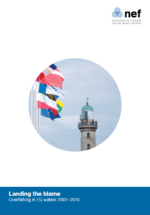Landing the Blame
Overfishing in EU waters 2001–2015
02 September 2015
Every year, the EU is provided with clear scientific advice on safe fishing levels, designed to encourage sustainable fishing. Despite this, European ministers set quotas far above what scientists recommend – leading to overfishing and lost economic potential. By analysing these decisions, we can determine which Member States are responsible for overfishing in EU waters.
Decades of overfishing have led to depleted fish populations and billions of euros in lost economic potential. Recent reforms of the EU’s Common Fisheries Policy (CFP) recognised the need to manage fish stocks according to best available science and affirmed Member States’ commitment to sustainable fishing.
A central management technique in the CFP, and a key component in the transition to sustainable fisheries, is the annual setting of fishing quotas – formally Total Allowable Catches (TACs) – for the following year.
These quotas are set by ministers of EU Member States during a closed door session of the Council of the European Union. Ministers are provided with scientific advice by ICES (International Council for the Exploration of the Sea), covering most commercial fish stocks under quota management in the North-East Atlantic. Despite this, ministers exit the meeting with many TACs for their fishing fleets set above scientific recommendations.
Using published data from ICES and the outcomes of the TAC negotiations we are able to compare how the scientific advice matches up with the TACs that have been set. These datasets provide a total of 248 TACs over 15 years, although data issues do exclude some of the potential comparisons. The resulting database and comparisons have been published online in conjunction with this research.
After combining all the TAC comparisons, our results show that from 2001 to 2015 the agreed TACs have exceeded scientific advice by 20%, falling from 33% to 7% over the time period. While the number of TACs set above scientific advice has remained consistent with approximately 7 out of every 10 TACs continuing to be set above advice, the amount by which advice is exceeded for these TACs has decreased from 42% to 18%. As long as TACs continue to be set above scientific advice, the problem of overfishing is expected to continue.
Who is to blame for this?
As different TACs are allocated amongst different combinations of Member States, we can analyse the link between the presence of particular Member States in a TAC decision and whether the outcome followed scientific advice. Through this method we can identify the Member States responsible for pushing TACs above scientific advice, and thus working against the transition to sustainable fisheries in the EU.
The Member States with the largest amount of gross tonnage above scientific advice are Denmark, the UK and Spain. As a percentage of their total fishing quota, accounting for differences in size, the Member States with the highest amount of excess TAC are Spain, Portugal and the Netherlands. While published data does not allow for a full comparison, TACs that involved non-Member States such as Norway, the Faroes and Iceland are even more likely to exceed scientific advice.
An end to overfishing in EU waters requires concerted action from all Member States. While there has been steady progress in adhering to scientific advice, the practice of setting TACs above advice still remains, delaying the transition to sustainable fisheries. In making this dataset of comparisons available, we hope to further encourage individual ministers to follow scientific advice and guarantee the sustainable management and full economic potential of our shared natural resources.
Campaigns Landing the blame
Topics Fisheries & farming







